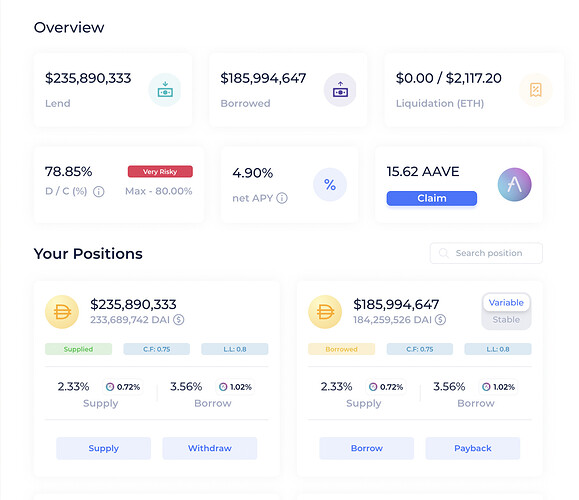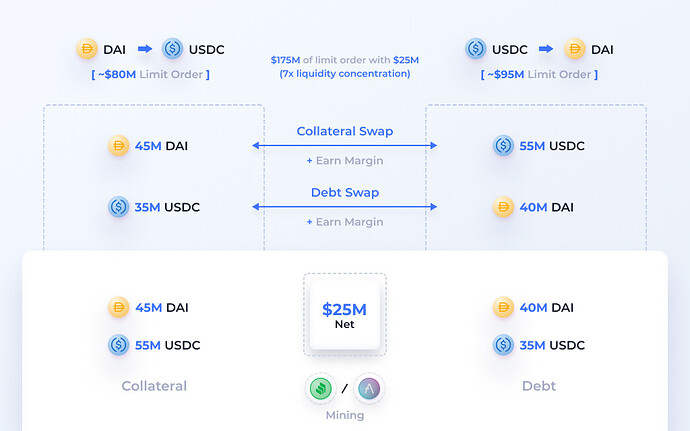There are vast amount of untapped and under-utilised stablecoin liquidity is sitting idle in protocols. This is partly due to liquidity mining events generated by some of the largest protocols like COMP and AAVE.
Instadapp has become one of the most significant and fertile lands for farming AAVE and COMP. In particular, many users with large balances are looping their positions to maximise their returns by 4 to 10x, usually accomplished with stable coin pairs like DAI to DAI or USDC to USDC.
Let’s take an example of a COMP farmer who has a starting capital of 10M USDC. This farmer can maximize the exposure by up to 40M USDC collateral & 30M USDC debt. This position mines COMP with an exposure equivalent to 70M.
However, while the assets are provided, they gain interest, but they essentially sit idle. What if the assets in this position could be used as a liquidity source for stablecoin swaps while earning COMP & AAVE, thus increasing their utility and capital efficiency.
On Compound, users can make a limit order up to 7x their net value, while on Aave, they can go up to 9x. At the time of writing this post, Instadapp has 28 users with a total of 35 positions with more than 10M DAI/USDC in collateral/debt in Aave/Compound - which adds up to ~$2.31B collateral & ~$1.83B debt and potentially ~$4.14B available capital for automated stablecoin swaps.
For example, the user described above can provide liquidity for stablecoin to farm COMP/AAVE and earn market-making fees by creating stablecoin swap orders on top of that lending position, making an entirely new source of cashflow.
Also, when the user sets a collateral & debt swap limit order. Their collateral & debt is in USDC. The user can sell at a slight premium, increasing their collateral & minimising their debt over time.
(see the example below).
The Instadapp Protocol enables users to create stablecoin orders for and within their DeFi deposits & borrowings on Aave and Compound.
Users can set a limit to buy & sell. For example, a 10M USDC debt user can create a limit order of a range to sell 1 USDC at 1.0005 DAI and buy 1 USDC at 0.9995 DAI. That means the user’s position will sell DAI & USDC at a premium. The user’s position will only revolve under that defined range limits.
- When all debt is in USDC: The user’s position will swap from DAI to USDC at premium and trade vice-versa. Receive USDC → Payback USDC → Borrow DAI → Return DAI.
- When all debt is in DAI: The user’s position will swap from USDC to DAI at premium and trade vice-versa. Receive DAI → Payback DAI → Borrow USDC → Return USDC.
-
When some debt is in DAI & some in USDC: The user’s position will swap from USDC to DAI or DAI to USDC at a premium.
- USDC debt will provide USDC to DAI swap for traders: Receive USDC → Payback USDC → Borrow DAI → Return DAI.
- DAI debt will provide DAI to USDC swap for traders: Receive DAI → Payback DAI → Borrow USDC → Return USDC.
The above example is of debt swap, understand similarly for collateral swap.
Extra Thoughts:
Currently, ~$1.3B DAI is being held up in Compound & Aave, and DAI is unstable for a while. The range orders like this will mobilize the idle DAI sitting on lending protocols like Compound & Aave as market makers increase the DAI supply in the market, meaning less DAI being generated using USDC.
- Increases peg stability with the minimal market intrusion.
- Generates a passive payback for debts over time. Increased stablecoin instability decreases the holder’s overall liabilities, winning in uncertain times!
Instadapp Protocol is in the best position to build this system, creating market efficiency and adding a new stream of income for Instadapp users by utilizing idle assets. I look forward to hearing your thoughts.

